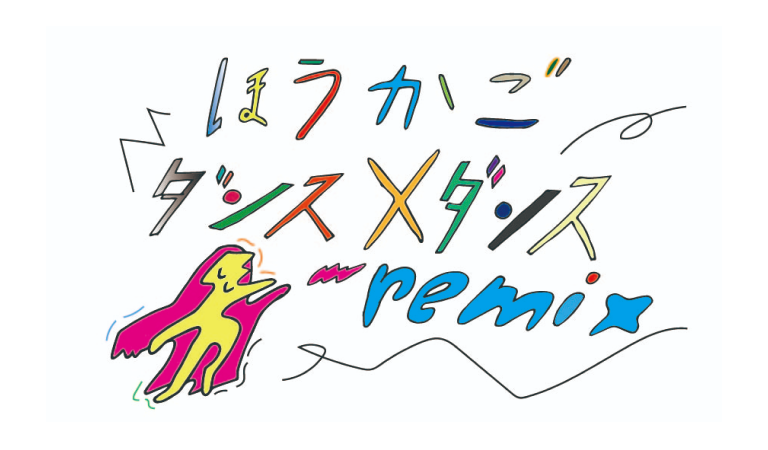ADD Kunitachi City
Document of the Research and Workshops
Reina Kimura and Daisuke Muto
Research
Kunitachi City is an educational district with universities and other facilities, and there are many individuals and groups that have developed their own community activities. The Kunitachi Community Arts Center, the base of ADD Kunitachi City, is used for ballet and jazz dance rehearsals and presentations and also hosts contemporary dance workshops.
In the course of our research, we came across a dance team for elementary and junior high school students called "LOCK★SHOW", and observed their practice at Kunitachi 6th Elementary School. It was originally started as a club activity at this school. Although Hana Sato (now a teacher at another school) was teaching the children who had no experience in dance, it was rather the children that were taking the lead in the practice.
At Yabo Tenmangu Shrine, Osamu Jareo saw an ancient form of shishimai (lion dance) at the annual festival in September. Among the three-piece shishimai commonly seen in the Kanto region, this is an older form that dates back to the Heian period. Through Hiroki Tsudo, the assistant to the chief of the shrine, we were able to meet Maurice Morancie from Trinidad and Tobago, who is interested in this shishimai and comes to see it every year. He works as an ALT (Assistant Language Teacher) at a high school in Fuchu, and when we asked him if he could teach the Trinidad and Tobago dance to the children, he agreed to join us with a friend from his hometown who works in Tokyo.
Hitotsubashi University is famous for its ballroom dancing club, but many of its teachers seem to be unique as well. Professor Naofumi Suzuki of the Faculty of Sociology, who has once participated in a dance workshop in Kunitachi Community Arts Center, has an extraordinary background as a former member of the Scottish national lacrosse team his research theme is sports and social inclusion. On the other hand, part-time lecturer Satoshi Hasegawa is an active yamabushi (mountain priest) who teaches about ancient Japanese martial arts at the university. Both are different from so-called "dance", but lacrosse is originally a religious ritual of North American indigenous people, and yamabushi has close cultural ties with kagura and other traditional performing arts, so we asked them to join the workshop.
In Kunitachi City, it became visible that there are relationships between various educational professionals and dance.
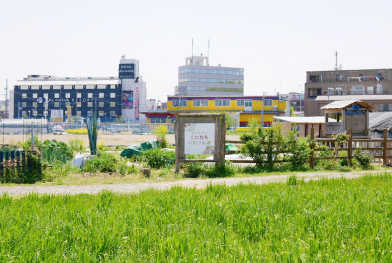
"Kunitachi Hatakembo" is a gathering place to enjoy farming. They also organize events.
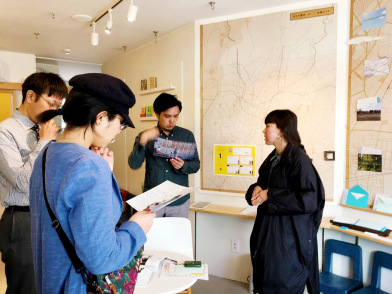
We talked to members at "Kunitachi Honten", a space for socializing through books.
Workshop
ADD Kunitachi's base is the Community Arts Center. In addition to holding various events such as music, theater, rakugo (comic storytelling), and dance, the hall also has music practice rooms, studios, and ateliers, all of which are enjoyed by the citizens. The lobby on the first floor is open to the public, and after school children come here to study or play games. Although it is not really a children's center, it seems to be functioning as a place for children.
The ADD workshop "Hôkago Dance Troupe" was mainly held in the music practice room in the basement of the Center, but we also occasionally used the adjacent Kunitachi Community Sports Center when necessary. Kaori Saito of the Arts Center not only supported the project and helped arrange the venue, but also connected ADD with the people of Kunitachi City by taking advantage of the characteristics of a cultural facility with close ties to the community. The Hôkago Dance Troupe quickly filled up with applications in advance, and many children continued to participate every time. (However, due to the prolonged interruption caused by COVID-19, we had to recruit participants anew later, and the faces of the children changed a great deal.) It was also very impressive to see how differently abled children were able to naturally interact with one another.
In Kunitachi City, we started with a somewhat unusual dance workshop by Osamu Jareo. Rather than learning a specific genre of dance, he gave the children an opportunity to experience the possibilities of communication using the body, such as the work of greeting each other by looking into their eyes, or the "seaweed dance" where all the participants closely lined up to make a wave. At the time, Kaoru Muramatsu, the production manager of ADD Kunitachi City, was expecting a baby, so Osamu challenged the children to "dance for the baby in her belly", and everyone came up with a dance and tried it together. Researcher Reina Kimura also taught a traditional dance from her hometown, Aomori.
Naofumi Suzuki, a lacrosse player, taught them the basics of using a racket and explained the cultural background of the sport of lacrosse with video clips. Osamu also challenged the children to combine lacrosse movements with different elements such as music and mimicry of animals.
Hana Sato of "LOCK★SHOW" began by warming up with castanets to catch the rhythm, and then everyone learned a choreography based on the hip hop. The children, who were shy at first, gradually began to enjoy jumping. The power of music and rhythm to make people dance was palpable.
Maurice Morancie, a native of Trinidad and Tobago, and his friend Zia Holder, from the same country, taught us the local folk dance called bélé. The children didn't have a clue when we asked, "Where is Trinidad and Tobago?" But when they found out that it is the country of the Caribbean Sea, the country of the "Pirates of the Caribbean", they rolled their eyes. In bélé, women dance with flared skirts and men with a cloth, each with a different step. The children also received furoshiki (wrapping cloth) each, and first practiced in groups of men and women. Finally, they danced a short choreography with the music. The two instructors also seemed to have enjoyed the rare experience of teaching their own country's dances in Japan.

In Osamu Jareo's workshop, children do not learn a specific dance style, but rather enjoy various forms of bodily communication. It is a learning through playing.
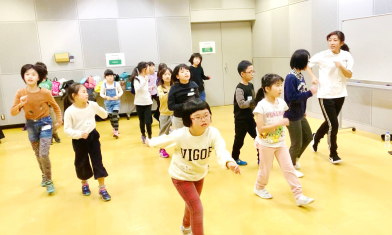
Hana Sato, an elementary school teacher, teaches them the joy of moving to the rhythm.
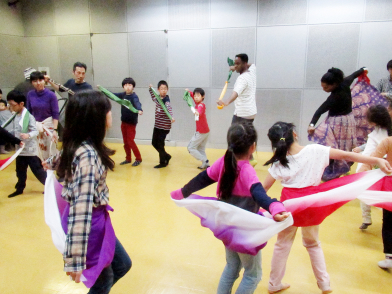
Besides the male and female dances, bélé has also a circle dance where everyone joins.

Exploring the use of a lacrosse racket. The boundary between "game" and "dance" fades.
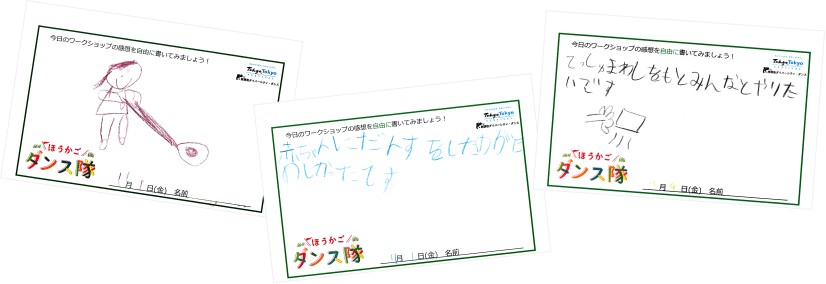
Feedbacks from the children after the workshop.
Workshop (Resumed)
In Kunitachi City, the program was interrupted by the COVID-19 pandemic after the eighth workshop, and a year and three months later, it was restarted with a combination of online and on-site workshops in four sessions. The six children who gathered for the workshop were taught by Hana Sato (hip hop) as before, and newcomers Minako Otake (bon dance), Kalehua Yoshida (hula), and Masami Kubota (body performance). In addition, Osamu taught the bélé that he had learned from Maurice and Zia.
Each workshop consisted of the first half where the children were taught the basics of the dance, and the second half where the children came up with their own original choreography based on the messages from the instructors to the children in light of the situation in COVID-19 such like "Why not look at the bright side?", "Don't give up", etc. With the support of Osamu and the staff, all the children practiced each other's choreography.
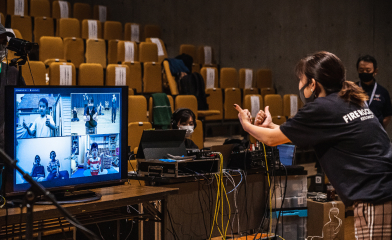
Though online, most children relaxed and enjoyed themselves with their families.
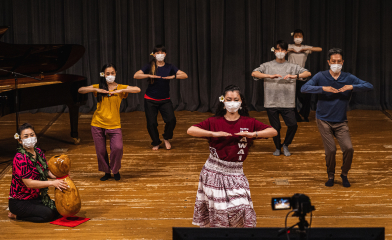
Contemporary dance practitioners also tried hula with Kalehua Yoshida and Mana Yoshida.
Showing
The event was held at the main hall of Kunitachi Community Arts Center, inviting parents and other related people. The children danced bon dance, bélé, hula, and their own original choreography with the instructors and Osamu. Guest musician Yusuke Kataoka played improvised music with piano and percussion, and Yoko Ando, saxophone player from the local area, also joined in to liven up the children's performance.
Finally, Masami Kubota appeared from the back of the audience. The children responded to his unconventional motions and appearances with unrestrained reactions, and the show closed with a mysterious excitement.
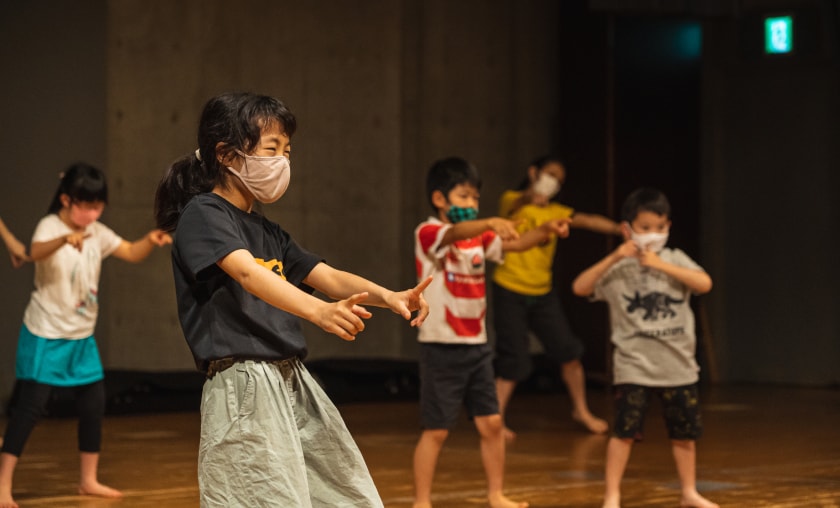
They performed the dances they learned and the dances they created one after another. The show, full of happenings, was delightful.
